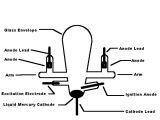An electrical rectifier is a device used to convert alternating current into direct current. Most of the rectifiers currently available on the market are based on solid state devices, regardless of application, although before the 1960s and prior to the development of high voltage solid state devices mercury arc valves were preferred for use in the production of high voltage direct currents.
The mercury arc valve rectifier was invented in 1902 by Peter Cooper Hewitt and was later improved by researchers throughout the European and American continents. It consists of a vacuumed glass envelope with one or more arms inside of which graphite rods are placed as anodes. The cathode of the device is made of a mercury pool. The number of the anode arms depends on the applications in which the rectifier is used and the number of phases.
For example, in the case of a single phase alternating current, two anodes are used while for three phase currents the mercury arc rectifier would have to have six anodes. The anodes are placed into glass arms in order to prevent the establishment of an electric arc between them. The glass envelope also contains two additional electrodes in the lower part which are used to start and maintain the electric arc.
Operation
The mercury arc valve is activated by generating a high-voltage arc between the mercury pool cathode and the starting electrode. This is typically done by bringing the starting electrode in contact with the cathode, at which point a current is being injected into an inductive circuit. As the starting electrode is being drawn out of the mercury pool, the electrical contact between the two is cut off and the inductive circuit responds by trying to maintain it.
When this happens, a high electromagnetic field is established, resulting in the creation of an electric arc. At the same time the cathode starts emitting free electrons due to the formed electric arc, triggering a shock ionization process through the mercury vapor contained inside the envelope. By contrast, the graphite anodes emit relatively small numbers of free electrons even when heated. Mercury ions are then attracted to the cathode, while the electrons are drawn to the anode at which point current rectification occurs.

 14 DAY TRIAL //
14 DAY TRIAL // 
